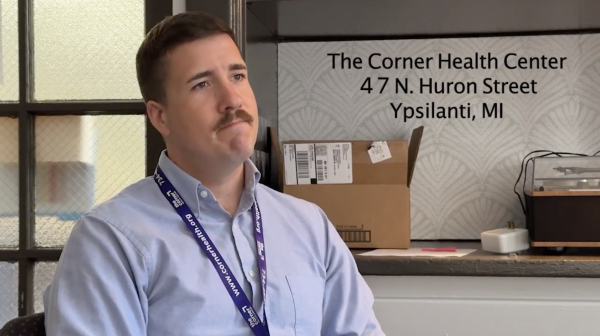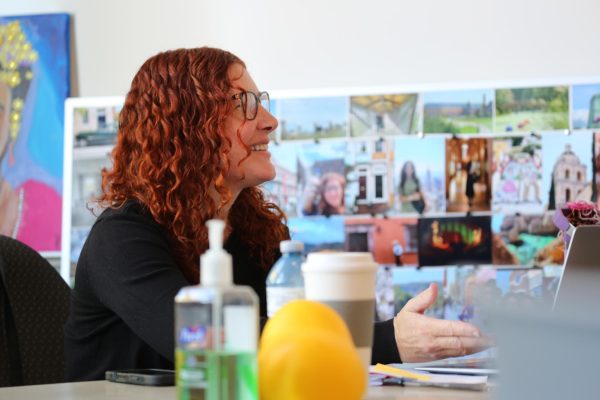The Scope of Ourselves
When eight-year-old Mira Schwarz saw an unfamiliar man in her Lawton Elementary School (LES) class, she had no idea he was a psychiatrist. Schwarz’s teacher told the class that this man would be ‘hanging out’ with them for the day and Schwarz didn’t think much of it. But two weeks later at an annual doctor’s appointment, the same man was in the office to assess if Schwarz needed therapy in the future.
“What I didn’t know [is that] with little kids in therapy, [psychiatrists] come in to watch you and take notes on how you’re doing to evaluate if you need therapy,” Schwarz said. “They asked me very personal questions which made me confused and nervous.”
After this surprise appointment, Schwarz began attending weekly therapy appointments to work through bullying issues she faced, having recently transferred to LES. With the exception of a few short breaks, Schwarz has attended therapy ever since.
Now a 17-year-old CHS senior, Schwarz’s nine years of therapy have helped her grow and evolve. From wrestling her embarrassment surrounding therapy as a child to finally understanding therapy’s importance, Schwarz has seen and felt firsthand how isolating the process of going to therapy can feel.
“I remember the stigma I thought in my own head when I was starting [therapy],” Schwarz said. “I thought there must be something super wrong with me [since] I needed to go to this person who was supposed to talk to me about my issues. I didn’t feel normal.”
Schwarz’s eight-year-old feelings of shame towards therapy were not irregular, according to Angela Fish, a supervising clinical psychologist at the University of Michigan Center for the Child and Family Department of Psychology. She defines the uneasiness surrounding therapy as a completely normal and understandable experience that nearly every child in therapy goes through.
“Many children have internalized the message, coming from anywhere, that they are not doing as well as they should be doing or that there is something wrong with going to therapy, and therefore wrong with them,” Fish said. “Children in this position are likely more cognizant, maybe, of their challenges than the strengths in their lives, and this can be a difficult feeling to overcome.”
Schwarz’s discomfort was further heightened by having to leave school every week for her appointments, drawing her classmates’ attention to her absence.
“I just told my friends I went to doctor’s appointments,” Schwarz said. “[Therapy] wasn’t something I felt comfortable sharing with other kids because I thought for sure [that] they were going to make fun of me.”
Despite her poignant childhood sentiments, Schwarz now looks back on her time in therapy with gratitude. As she went through especially anxiety-inducing school switches throughout her childhood, having a long-term therapist to help work through her complex surrounding emotions has meant everything to Schwarz.
“Therapy helped me figure out how to navigate the challenges of growing up and how to handle myself with patience,” Schwarz said. “Every session was an hour of reflection and advice [where my therapist and I] figured out how to go about everything that I’m experiencing, and that way of sorting through myself worked very well for me.”
Juxtaposing Schwarz’s current stance on therapy, Jocelyn Kincaid-Beal, another CHS senior, had an experience with child therapy that they describe as ‘unhelpful.’ Kincaid-Beal’s parents signed them up for therapy at five years old after noticing Kincaid-Beal’s exhibitance of self-image issues, but therapy was not something they took to as a child.
“When I went [to therapy] as a young kid, I simply didn’t talk to the therapist,” Kincaid-Beal said. “They would ask me questions, and I just wouldn’t say a word.”
Another common occurrence in child therapy, avoidance and muteness towards a therapist can have a multitude of different meanings. As Fish explains, some children may not be ready to discuss emotions that they have trouble acknowledging. Factors such as timing the first appointment and the relationship between patient and therapist are key determinants of success.
“Sometimes a longer process is needed to build rapport [between the patient and the therapist] and really hear what’s going on from the child or adolescent’s perspective,” Fish said. “When we can get there, usually we can come up with some shared goals between the child and the parents and therapist and do some real, good work. But sometimes, it’s not the right time for therapy, not the right therapist or not the right type of therapy, and that is completely acceptable too.”
Now, nearly 13 years since their first appointment, Kincaid-Beal reflects on their relationship with therapy with mixed emotions. Specifically, they reflect on how therapy helped them see themselves and what it was “supposed” to help Kincaid-Beal with as a patient.
“For a long time, I thought that I was cool with therapy,” Kincaid-Beal said. “I knew that it was helpful for me, but it felt like I was supposed to be doing it. It felt like a chore, and I never liked it [as a kid].”
Despite facing several personal setbacks through therapy as an elementary and middle schooler, Kincaid-Beal has recently begun seeing a new therapist. They researched therapists and found one that they believed would work better for them, instead of seeing one who their parents chose on their behalf.
“I’m going to have to try to unlearn a lot of bad stigma I found when I did therapy as a kid,” Kincaid-Beal said. “I’m not making a huge effort at that now, but I think [that] going to therapy again is a good step for me to take.”
Therapy can vary in how much or how little it helps the people who use it. Kincaid-Beal and Schwarz have experienced varying degrees of this help since they started as elementary-aged children, but both have come to the current conclusion that it is a system they want in their lives. This variance is something that Fish acknowledges, and she views therapy with an open and honest perspective.
“Although therapy is an option that works well for many, it doesn’t work for everyone,” Fish said. “Working towards any goal in life can be as enriching as therapy and [can] teach self-control too. There are many other ways for people to get that same fulfillment that therapy can supply. It’s no easy task to work within the stigma of therapy, to work within the scope of yourself, and to navigate being human.”









